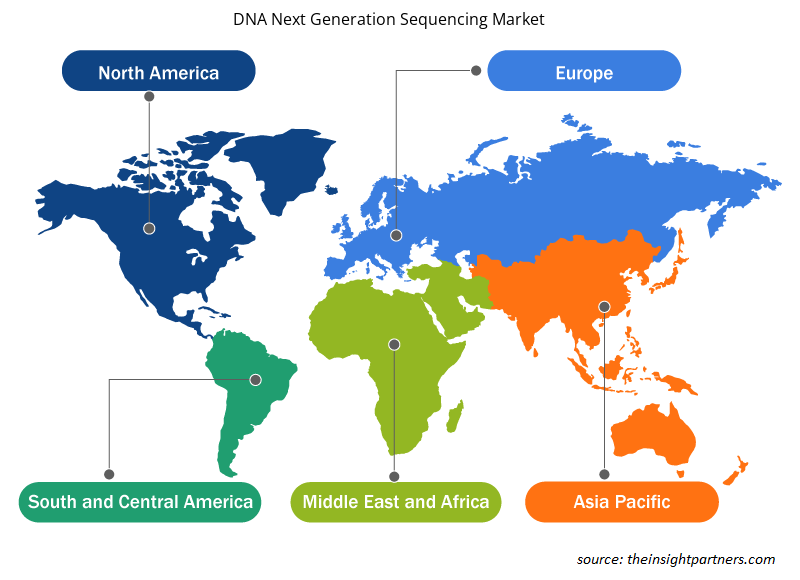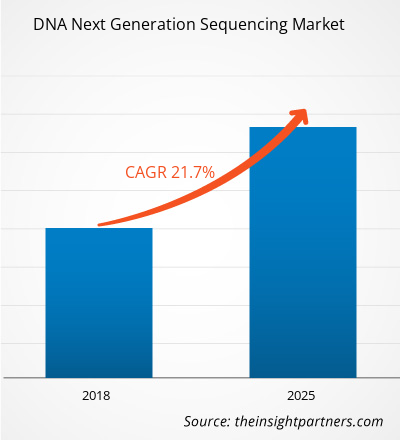[調査レポート] DNA次世代シーケンシング市場規模は、2017年の48億9,850万米ドルから2025年には227億1,690万米ドルに達すると推定されており、2018年から2025年にかけて21.7%のCAGRで成長すると予想されています。
次世代シーケンシングは、ハイスループットシーケンシングとも呼ばれます。NGSにより、 DNA サンプル内の塩基対の迅速なシーケンシングが可能になります。NGSは創薬アプリケーションを推進し、個別化医療、遺伝性疾患、臨床診断の未来を可能にします。さらに、次世代シーケンシング ( NGS )は、スケーラビリティ、超高スループット、高速でゲノム全体のヌクレオチドの順序を確立できる超並列シーケンシング技術です。後続のシーケンシング反応のためにサンプルを準備することが含まれるため、DNAプレシーケンシングは、トータルシーケンシングプロトコルの中で最も重要なプロセスの 1 つです。世界のヘルスケア分野では、NGS は臨床検査室分析、検査、疾患診断に着実に統合されつつあります。薬理ゲノム学では、NGS は創薬プロセスのスピードアップに広く採用されています。
DNA次世代シーケンシング市場の成長は、世界中で癌症例数が増加していること、研究調査が増加していること、研究機関と市場関係者の協力が増加していること、DNA 次世代シーケンシングの応用が増加していること、シーケンシング技術の技術的進歩によるものとされています。しかし、熟練した専門家の不足が、DNA 次世代シーケンシング市場全体の成長に重大な影響を与えると予想されます。
要件に合わせてレポートをカスタマイズする
このレポートの一部、国レベルの分析、Excelデータパックなど、あらゆるレポートを無料でカスタマイズできます。また、スタートアップや大学向けのお得なオファーや割引もご利用いただけます。
- このレポートの主要な市場動向を入手してください。この無料サンプルには、市場動向から見積もりや予測に至るまでのデータ分析が含まれます。
市場分析
シーケンシング価格の低下とシーケンシング方法の技術的進歩がDNA次世代シーケンシング市場を牽引
近年、次世代シーケンシングの価格は大幅に下がっています。2000 年、ヒトゲノムのシーケンシングのコストは 37 億ドルで、完了までに 13 年かかりました。しかし、近年のコストは 2006 年に 1,000 万ドルに下がり、2012 年にはさらに下がり、プロセスに必要な日数も短くなりました。イルミナやロシュなどの DNA 次世代シーケンシング市場の大手企業は、コスト効率が高く、シーケンシング プロセスにかかる時間が短い画期的な技術を導入しています。
さらに、分子生物学の分野における進歩は、シーケンシング手順も同様に強化してきました。多くの業界プレーヤーが、ここ数年で革新的なNGS技術を考案しました。たとえば、Pacific BiosciencesはSequel、Oxford NanoporeはPromethIONです。さらに、市場を席巻している3つの高度なNSGシステムには、Roche GS FLX(454)、Illumina HiSeq 2000(Solexa)、AB SOLiD(Agencourt)があります。
このプロセスのさらなる改良と自動化により、シーケンシング データは増加し続け、時間管理も効率化され、研究者はヒトゲノム プロジェクトで重要なマイルストーンを達成できるようになりました。NGS により、シーケンスベースの遺伝子発現分析はアナログ技術に代わる「デジタル」な方法になりました。ゲノム シーケンシングの進歩により、シーケンシングは簡単かつ正確になりました。これらの技術の進歩により、近い将来、DNA 次世代シーケンシングの市場規模が拡大する可能性があります。
製品ベースの洞察
世界の DNA 次世代シーケンシング市場は、製品に基づいて、プラットフォーム、サービス、消耗品に分類されています。プラットフォーム セグメントはさらに、HiSeq シリーズ、MiSeq シリーズ、SOLiD、Ion Torrent、Pacbio Rs II、Sequel Systems などに細分化されています。また、サービス セグメントは、シーケンシング サービスとデータ管理および分析サービスに細分化されています。さらに、消耗品セグメントは、サンプル消耗品の準備とその他の NGS 消耗品に細分化されています。消耗品セグメントは、2017 年に DNA 次世代シーケンシング市場の製品サブセグメントの中で大きなシェアを占め、予測期間中も同様の傾向が続くと予想されています。最近の NGS プラットフォームでは、単一分子シーケンシング (SMS) と呼ばれる新しいシーケンシング方法を採用しています。この方法では、DNA の事前増幅が不要なため、PCR 関連のエラー リードや繰り返し領域への増幅バイアスを回避できます。過去 5 年間で、次世代シーケンシング (NGS) は研究から臨床使用へと移行しました。少なくとも 14 か国が大規模な集団のゲノムを解析する取り組みを立ち上げており、2025 年までに世界中で 6,000 万人以上のゲノムが解析されると予測されています。
アプリケーションベースの洞察
世界の DNA 次世代シーケンシング市場は、アプリケーションに基づいて、診断、創薬、精密医療、およびその他のアプリケーションに分類されます。診断セグメントは 2017 年に最大のシェアを占め、今後 5 ~ 6 年で大幅な成長が見込まれています。診断ゲノムケアにおける次世代シーケンシング (NGS) 技術の使用には、精度と正確さが必要です。NGS 技術は、コスト効率の高いシーケンシングを使用して、全ゲノム シーケンシングから患者に関するゲノム情報を取得し、臨床処置を実行します。次世代シーケンシングは、最終的に、さまざまな遺伝性疾患を診断するための従来の技術に取って代わりつつあります。遺伝子ごとのアプローチではなく、単一のテストで大量の遺伝子セットに対応できるようになりました。
エンドユーザーベースの洞察
エンドユーザーに基づく世界市場は、学術研究機関、製薬およびバイオテクノロジー企業、病院および診療所、およびその他のエンドユーザーに区分されています。学術研究機関セグメントは、予測期間中に最も高い成長が見込まれています。シーケンスは、科学者が特定の DNA セグメントに含まれる遺伝情報の種類を見つけるのに役立ちます。たとえば、科学者はシーケンス情報を使用して、DNA のどの部分に遺伝子が含まれているか、どの部分に遺伝子をオンまたはオフにする制御指示が含まれているかを判断することができます。ランダムまたはショットガン シーケンスに基づく自動化された工業化アプローチは、メリーランド州ロックビルのゲノム研究所 (TIGR) によって導入され、337 の新しいヒト遺伝子と他の生物からの 48 の相同遺伝子が公開されました。
DNA次世代シーケンシング市場の地域別洞察
予測期間を通じて DNA 次世代シーケンシング市場に影響を与える地域的な傾向と要因は、Insight Partners のアナリストによって徹底的に説明されています。このセクションでは、北米、ヨーロッパ、アジア太平洋、中東およびアフリカ、南米および中米にわたる DNA 次世代シーケンシング市場のセグメントと地域についても説明します。

- DNA次世代シーケンシング市場の地域別データを入手
DNA次世代シーケンシング市場レポートの範囲
| レポート属性 | 詳細 |
|---|---|
| 2017年の市場規模 | 49億米ドル |
| 2025年までの市場規模 | 227.2億米ドル |
| 世界のCAGR(2017年 - 2025年) | 21.7% |
| 履歴データ | 2015-2016 |
| 予測期間 | 2018-2025 |
| 対象セグメント | 製品別
|
| 対象地域と国 | 北米
|
| 市場リーダーと主要企業プロフィール |
|
市場プレーヤーの密度:ビジネスダイナミクスへの影響を理解する
DNA 次世代シーケンシング市場は、消費者の嗜好の変化、技術の進歩、製品の利点に対する認識の高まりなどの要因により、エンドユーザーの需要が高まり、急速に成長しています。需要が高まるにつれて、企業は提供内容を拡大し、消費者のニーズを満たすために革新し、新たなトレンドを活用し、市場の成長をさらに促進しています。
市場プレーヤー密度とは、特定の市場または業界内で活動している企業または会社の分布を指します。これは、特定の市場スペースに、その規模または総市場価値と比較して、どれだけの競合相手 (市場プレーヤー) が存在するかを示します。
DNA次世代シーケンシング市場で事業を展開している主要企業は次のとおりです。
- イルミナ株式会社
- サーモフィッシャー
- キアゲンNV
- 北京ゲノム研究所
- パーキンエルマー株式会社
免責事項:上記の企業は、特定の順序でランク付けされていません。

- DNA次世代シーケンシング市場のトップキープレーヤーの概要を入手
製品の発売と承認は、企業が世界的な足跡と製品ポートフォリオを拡大するために一般的に採用されている戦略です。さらに、市場プレーヤーは顧客を拡大するためのパートナーシップ戦略に重点を置いており、これにより世界中でブランド名を維持できます。市場シェアは、市場プレーヤーによる新しい革新的な製品の開発により繁栄すると予想されています。関連する市場に存在する市場参加者の一部は、THERMO FISHER SCIENTIFIC INC.、Illumina、Inc.、Qiagen NV、Beijing Genomics Institute、PerkinElmer、Inc.、F.Hoffman-La Roche Ltd.、Agilent Technologies、Eurofins Scientific、Oxford Nanopore Technologies Ltd、およびMacrogen Inc.です。
- 過去2年間の分析、基準年、CAGRによる予測(7年間)
- PEST分析とSWOT分析
- 市場規模価値/数量 - 世界、地域、国
- 業界と競争環境
- Excel データセット



Report Coverage
Revenue forecast, Company Analysis, Industry landscape, Growth factors, and Trends

Segment Covered
This text is related
to segments covered.

Regional Scope
North America, Europe, Asia Pacific, Middle East & Africa, South & Central America

Country Scope
This text is related
to country scope.
よくある質問
The DNA next generation sequencing market is growing at CAGR of 21.7% from 2018-2025.
Major market players such as Illumina and Roche have introduced breakthrough technologies that have enabled in the cost and time reduction in the sequencing.
As per forecast report, the market value of DNA next generation sequencing market in 2025 will be US$ 22,716.9 Million.
The growth of the global DNA next generation sequencing market is attributed to the increases in cancer prevalence, technological development and decreasing price of sequencing. Owing to factors like advances within the field of genetic science, development in several ways and methods for sequencing, there's a notable decline within the price of sequencing.
Trends and growth analysis reports related to Life Sciences : READ MORE..
The List of Companies
1. Illumina, Inc.
2. Thermo Fisher
3. Qiagen N.V.
4. Beijing Genomics Institute
5. PerkinElmer, Inc.
6. Hoffman-La Roche Ltd.
7. Agilent Technologies
8. Eurofins Scientific
9. Oxford Nanopore Technologies Ltd.
10. Macrogen Inc.
The Insight Partners performs research in 4 major stages: Data Collection & Secondary Research, Primary Research, Data Analysis and Data Triangulation & Final Review.
- Data Collection and Secondary Research:
As a market research and consulting firm operating from a decade, we have published and advised several client across the globe. First step for any study will start with an assessment of currently available data and insights from existing reports. Further, historical and current market information is collected from Investor Presentations, Annual Reports, SEC Filings, etc., and other information related to company’s performance and market positioning are gathered from Paid Databases (Factiva, Hoovers, and Reuters) and various other publications available in public domain.
Several associations trade associates, technical forums, institutes, societies and organization are accessed to gain technical as well as market related insights through their publications such as research papers, blogs and press releases related to the studies are referred to get cues about the market. Further, white papers, journals, magazines, and other news articles published in last 3 years are scrutinized and analyzed to understand the current market trends.
- Primary Research:
The primarily interview analysis comprise of data obtained from industry participants interview and answers to survey questions gathered by in-house primary team.
For primary research, interviews are conducted with industry experts/CEOs/Marketing Managers/VPs/Subject Matter Experts from both demand and supply side to get a 360-degree view of the market. The primary team conducts several interviews based on the complexity of the markets to understand the various market trends and dynamics which makes research more credible and precise.
A typical research interview fulfils the following functions:
- Provides first-hand information on the market size, market trends, growth trends, competitive landscape, and outlook
- Validates and strengthens in-house secondary research findings
- Develops the analysis team’s expertise and market understanding
Primary research involves email interactions and telephone interviews for each market, category, segment, and sub-segment across geographies. The participants who typically take part in such a process include, but are not limited to:
- Industry participants: VPs, business development managers, market intelligence managers and national sales managers
- Outside experts: Valuation experts, research analysts and key opinion leaders specializing in the electronics and semiconductor industry.
Below is the breakup of our primary respondents by company, designation, and region:

Once we receive the confirmation from primary research sources or primary respondents, we finalize the base year market estimation and forecast the data as per the macroeconomic and microeconomic factors assessed during data collection.
- Data Analysis:
Once data is validated through both secondary as well as primary respondents, we finalize the market estimations by hypothesis formulation and factor analysis at regional and country level.
- Macro-Economic Factor Analysis:
We analyse macroeconomic indicators such the gross domestic product (GDP), increase in the demand for goods and services across industries, technological advancement, regional economic growth, governmental policies, the influence of COVID-19, PEST analysis, and other aspects. This analysis aids in setting benchmarks for various nations/regions and approximating market splits. Additionally, the general trend of the aforementioned components aid in determining the market's development possibilities.
- Country Level Data:
Various factors that are especially aligned to the country are taken into account to determine the market size for a certain area and country, including the presence of vendors, such as headquarters and offices, the country's GDP, demand patterns, and industry growth. To comprehend the market dynamics for the nation, a number of growth variables, inhibitors, application areas, and current market trends are researched. The aforementioned elements aid in determining the country's overall market's growth potential.
- Company Profile:
The “Table of Contents” is formulated by listing and analyzing more than 25 - 30 companies operating in the market ecosystem across geographies. However, we profile only 10 companies as a standard practice in our syndicate reports. These 10 companies comprise leading, emerging, and regional players. Nonetheless, our analysis is not restricted to the 10 listed companies, we also analyze other companies present in the market to develop a holistic view and understand the prevailing trends. The “Company Profiles” section in the report covers key facts, business description, products & services, financial information, SWOT analysis, and key developments. The financial information presented is extracted from the annual reports and official documents of the publicly listed companies. Upon collecting the information for the sections of respective companies, we verify them via various primary sources and then compile the data in respective company profiles. The company level information helps us in deriving the base number as well as in forecasting the market size.
- Developing Base Number:
Aggregation of sales statistics (2020-2022) and macro-economic factor, and other secondary and primary research insights are utilized to arrive at base number and related market shares for 2022. The data gaps are identified in this step and relevant market data is analyzed, collected from paid primary interviews or databases. On finalizing the base year market size, forecasts are developed on the basis of macro-economic, industry and market growth factors and company level analysis.
- Data Triangulation and Final Review:
The market findings and base year market size calculations are validated from supply as well as demand side. Demand side validations are based on macro-economic factor analysis and benchmarks for respective regions and countries. In case of supply side validations, revenues of major companies are estimated (in case not available) based on industry benchmark, approximate number of employees, product portfolio, and primary interviews revenues are gathered. Further revenue from target product/service segment is assessed to avoid overshooting of market statistics. In case of heavy deviations between supply and demand side values, all thes steps are repeated to achieve synchronization.
We follow an iterative model, wherein we share our research findings with Subject Matter Experts (SME’s) and Key Opinion Leaders (KOLs) until consensus view of the market is not formulated – this model negates any drastic deviation in the opinions of experts. Only validated and universally acceptable research findings are quoted in our reports.
We have important check points that we use to validate our research findings – which we call – data triangulation, where we validate the information, we generate from secondary sources with primary interviews and then we re-validate with our internal data bases and Subject matter experts. This comprehensive model enables us to deliver high quality, reliable data in shortest possible time.


 このレポートの無料サンプルを入手する
このレポートの無料サンプルを入手する